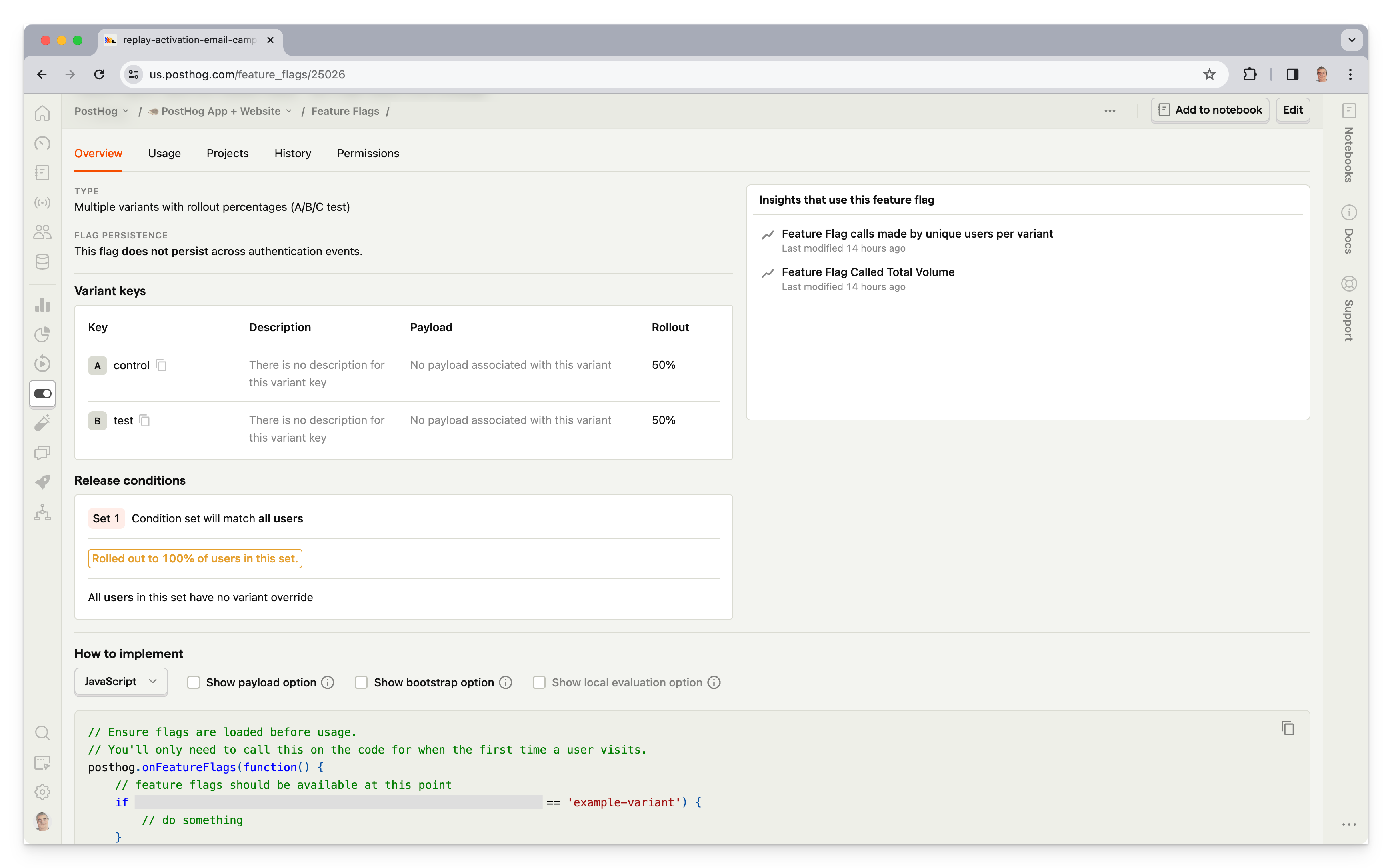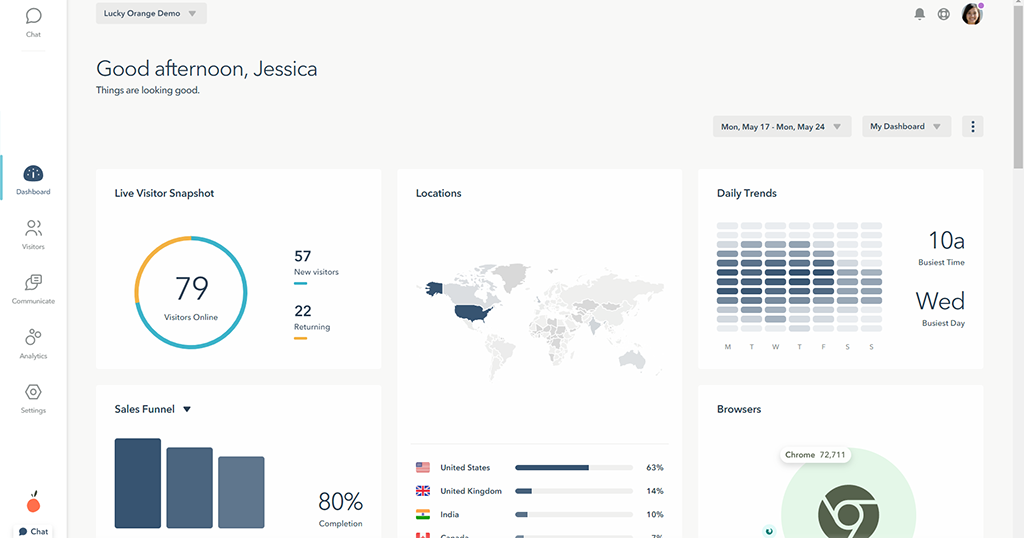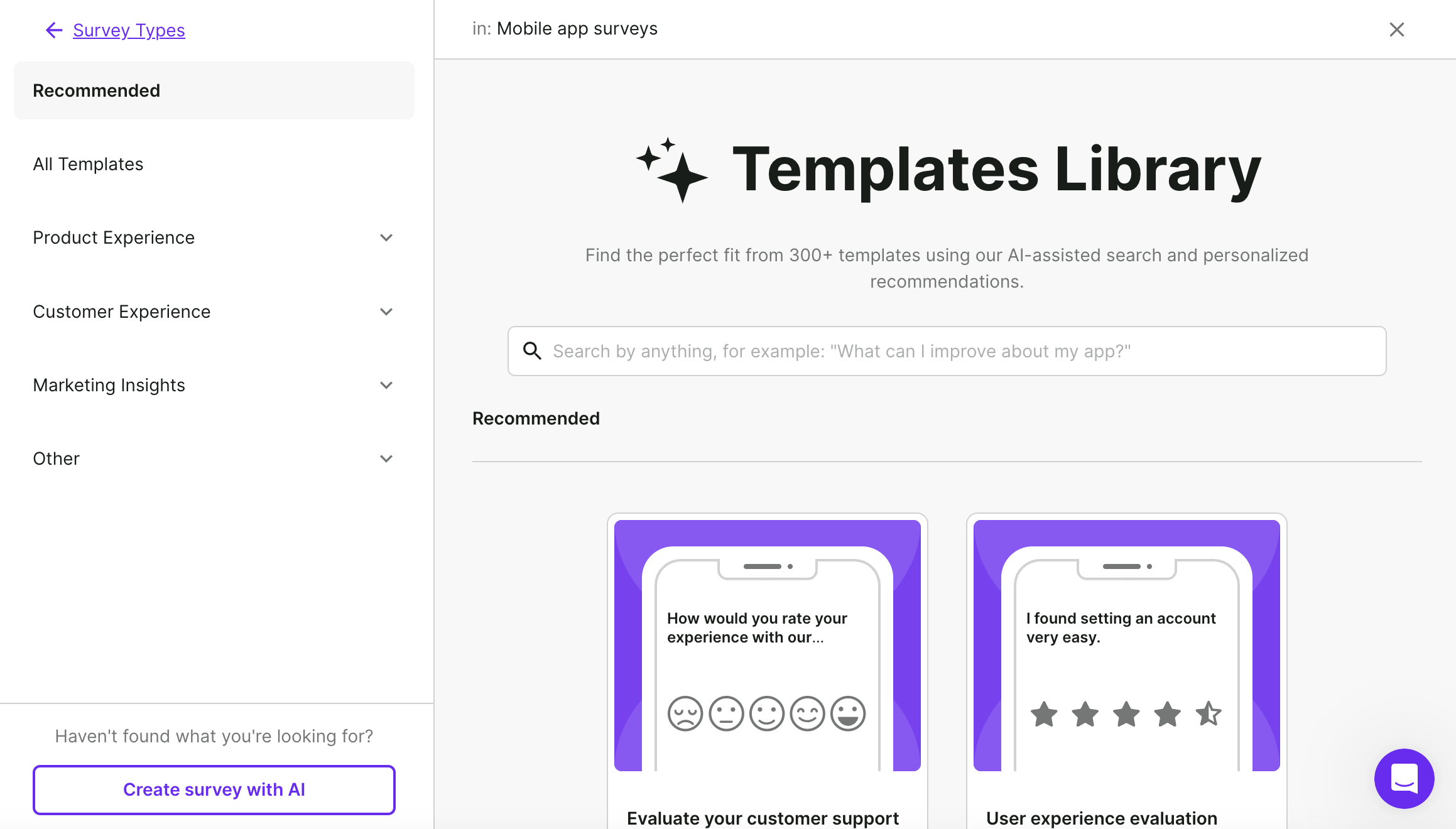The best Sprig alternatives & competitors, compared
Jun 18, 2024

On this page
- 1. PostHog
- What is PostHog?
- How does PostHog compare to Sprig?
- Why do companies use PostHog?
- 2. Hotjar
- What is Hotjar?
- Key features
- How does Hotjar compare to Sprig?
- Why do companies use Hotjar?
- 3. Pendo
- What is Pendo?
- How does Pendo compare to Sprig?
- Why do companies use Pendo?
- 4. FullStory
- What is FullStory?
- How does FullStory compare to Sprig?
- Why do companies use FullStory?
- 5. Crazy Egg
- What is Crazy Egg?
- How does Lucky Orange compare to Mouseflow?
- Why do companies use Crazy Egg?
- 6. Lucky Orange
- What is Lucky Orange?
- How does Lucky Orange compare to Sprig?
- Why do companies use Lucky Orange?
- 7. Survicate
- What is Survicate?
- How does Survicate compare to Sprig?
- Why do companies use Survicate?
- Is PostHog right for you?
1. PostHog
- Founded: 2020
- Similar to: Hotjar, Pendo
- Typical users: Engineers and product teams

What is PostHog?
PostHog (that's us 👋) is an open-source platform that combines surveys, product analytics, session replay, A/B testing, and feature flags. This means it's not only an alternative to Sprig, but also tools like Mixpanel and LaunchDarkly.
According to BuiltWith, as of June 2024, 4,661 of the top million websites deploy PostHog, significantly more than the 378 that use Sprig.
Key features
💬 Surveys: Target surveys by event or user properties. Templates for net promoter score (NPS), product-market fit (PMF) surveys, and more.
📈 Product analytics: Custom trends, funnels, user paths, retention analysis, and segment user cohorts. Also, direct SQL querying for power users.
📺 Session replays: View exactly how users are using your site. Includes event timelines, console logs, network activity, and 90-day data retention.
🧪 A/B tests: Experiment in your app with up to nine test variations and track impact on primary and secondary metrics. Auto-calculate test duration, sample size, and statistical significance.
🚩 Feature flags: Rollout features safely with local evaluation (for faster performance), JSON payloads, and instant rollbacks.
How does PostHog compare to Sprig?
PostHog and Sprig have similar capabilities when it comes to surveys and replays, but differ on other features. Sprig offers AI analysis to summarize surveys and feedback, while PostHog includes entire features Sprig doesn't have, like product analytics, A/B testing, and feature flags.
They also differ on support for mobile apps. All of Sprig's features are available for mobile apps, whereas PostHog doesn't yet offer surveys on mobile – although it does support replays and heatmaps on apps.
| PostHog | Sprig | |
Surveys Collect feedback and run satisfaction surveys | ✔ | ✔ |
Session replay Watch real users on your site; discover friction points | ✔ | ✔ |
Heatmaps Visualize where users click and interact on your site | ✔ | ✔ |
Scroll maps See how far users scroll on websites and apps | ✔ | ✖ |
Product analytics Track trends, funnels, user paths, and retention | ✔ | ✖ |
A/B testing Test changes and analyze their impact | ✔ | ✖ |
Funnels and journey maps Measure conversion and track the paths users take | ✔ | ✖ |
Feature flags Deploy features safely with targeting and percentage rollouts | ✔ | ✖ |
AI analysis Surface user pain points using AI | ✖ | ✔ |
Mobile support Pre-built SDKs and support for iOS, Android, and React Native | No surveys | ✔ |
Cookieless tracking option Use session replays and analytics without cookie consent banners | ✔ | ✔ |
Open source Audit code, contribute to roadmap, and build integrations | ✔ | ✖ |
Why do companies use PostHog?
According to G2 reviews, companies use PostHog because:
It's many tools in one: PostHog can replace Sprig (surveys and heatmaps), Amplitude (analytics), and Statsig (A/B testing and feature flags). This simplifies workflows and ensures all product data is in one place.
They need a complete picture of users: PostHog includes every tool necessary to understand users and build better products. This means creating funnels to track conversion, watching replays to see where users get stuck, testing solutions with A/B tests, and gathering feedback with user surveys.
Pricing is transparent and scalable: Reviewers appreciate how PostHog's pricing scales as they grow. There's a generous free tier. Companies eligible for PostHog for Startups also get $50k in additional free credits.
Bottom line
For teams looking for all the tools they need to improve their products, PostHog makes for a great alternative. This is especially true for startups and scaleups thanks to it having a generous free tier.
2. Hotjar
- Founded: 2014
- Most similar to: Pendo, PostHog
- Typical users: Product designers, researchers, and marketers

What is Hotjar?
Hotjar is a tool for understanding user behavior. It provides heatmaps, replays, surveys, and interviews to capture and display the qualitative aspects of your site and app. Teams use it to discover and address pain points on their site and app, which helps them improve customer experiences.
According to BuiltWith, Hotjar is by far the most popular option on this list as of June 2024. 67,108 of the top million sites use it, compared to the 378 of Sprig.
Key features
📝 Surveys: Ask users questions to hear their opinions on features, flows, and what you should build next.
🔥 Heatmaps: See what parts of your pages get attention and how far down the page users get.
🎥 Recordings: Replay real user sessions and see what they see; discover hidden friction.
🗣️ Feedback: Learn what your users are thinking. Find out their likes, dislikes, and satisfaction.
👔 Interviews: Talk to real users to share ideas, test designs, and get live feedback.
How does Hotjar compare to Sprig?
Hotjar and Sprig have comparable features when it comes uncovering insights on marketing sites and web apps. Hotjar lacks supports for mobile apps, though.
| Hotjar | Sprig | |
Surveys Collect feedback and run satisfaction surveys | ✔ | ✔ |
Session replay Watch real users on your site; discover friction points | ✔ | ✔ |
Heatmaps Visualize where users click and interact on your site | ✔ | ✔ |
Scroll maps See how far users scroll on websites and apps | ✔ | ✖ |
Product analytics Track trends, funnels, user paths, and retention | ✖ | ✖ |
A/B testing Test changes and analyze their impact | ✖ | ✖ |
Funnels and journey maps Measure conversion and track the paths users take | ✔ | ✖ |
Feature flags Deploy features safely with targeting and percentage rollouts | ✖ | ✖ |
AI analysis Surface user pain points using AI | ✖ | ✔ |
Mobile support Pre-built SDKs and support for iOS, Android, and React Native | ✖ | ✔ |
Cookieless tracking option Use session replays and analytics without cookie consent banners | ✖ | ✔ |
Open source Audit code, contribute to roadmap, and build integrations | ✖ | ✖ |
Why do companies use Hotjar?
According to G2 reviews, users are fans of Hotjar because:
Insights on user behavior: Hotjar captures what users are doing, where their attention is going, and how they are spending their time. Users love the insights they get with Hotjar's tools.
Simple for non-technical users: Hotjar is easy to set up. Non-technical roles like designers, marketers, and product managers find it simple to use. The visuals do a good job of making data clear.
Heatmaps and scrollmaps: Seeing clicks and scroll depth down works well and creates actionable insights for design, marketing, and content teams. Helps improve UX and page designs.
Bottom line
Hotjar is a good option for product and marketing teams who want to do in-depth analysis on user journeys within products, especially compared to other Sprig alternatives like Crazy Egg that are more focused on e-commerce and small business users.
3. Pendo
- Founded: 2013
- Similar to: PostHog, Hotjar
- Typical users: Product managers and customer success teams

What is Pendo?
Pendo is a product experience platform that offers surveys, session replays, product analytics, in-app guides, and product validation tools. It's primarily used by product managers and customer success teams.
According to BuiltWith, 3,166 of the top million websites deploy Pendo as of June 2024. This is more than 8x the 378 that use Sprig.
Key features
📝 Surveys: Ask users questions to hear their opinions on features, flows, and what you should build next.
📘 In-app guides: Deliver personalized guidance to customers inside your app, without changing the code.
📣 User feedback: A centralized location to capture product feedback. Capture manually or with in-app prompts.
📊 Product analytics: Learn how users are using your app with event autocapture. Analyze with funnels, trends, and retention analysis.
📹 Session replay: Watch real users use your product and understand the behavior behind your analytics data.
🛣️ Product validation and roadmaps: Manage your backlog and plan your roadmap to create alignment.
How does Pendo compare to Sprig?
Pendo is the most similar alternative to Sprig. It includes all of the key features and more (like analytics and funnels).
| Hotjar | Sprig | |
Surveys Collect feedback and run satisfaction surveys | ✔ | ✔ |
Session replay Watch real users on your site; discover friction points | ✔ | ✔ |
Heatmaps Visualize where users click and interact on your site | ✔ | ✔ |
Scroll maps See how far users scroll on websites and apps | ✖ | ✖ |
Product analytics Track trends, funnels, user paths, and retention | ✔ | ✖ |
A/B testing Test changes and analyze their impact | ✖ | ✖ |
Funnels and journey maps Measure conversion and track the paths users take | ✔ | ✖ |
Feature flags Deploy features safely with targeting and percentage rollouts | ✖ | ✖ |
AI analysis Surface user pain points using AI | ✔ | ✔ |
Mobile support Pre-built SDKs and support for iOS, Android, and React Native | ✔ | ✔ |
Cookieless tracking option Use session replays and analytics without cookie consent banners | ✖ | ✔ |
Open source Audit code, contribute to roadmap, and build integrations | ✖ | ✖ |
Why do companies use Pendo?
According to G2 reviews, customers use Pendo for:
Customer support and feedback: Product and customer support value Pendo for its feedback collection and roadmapping capabilities. Users like how it helps them figure out what to work on next.
Improving onboarding: Pendo's in-app guides combined with analytics features facilitate experimenting with new onboarding flows and improving user adoption.
Product planning: Pendo's data tools, product validation, and roadmap features help align internal teams and stakeholders on product development.
Bottom line
Pendo makes for a solid alternative to Sprig thanks to its matching feature set while also being self-serve. Pendo's opaque pricing can be a turnoff to some, though.
4. FullStory
- Founded: 2012
- Similar to:
- Typical users: Product managers, customer success, and support teams

What is FullStory?
FullStory describes itself as a "behavioral data platform," which is code for product analytics with a side of session replay and mobile app analytics. It focuses on behavioral analytics, and like PostHog, it supports event autocapture, so you don't have to manually code every event you want to capture.
According to BuiltWith, as of June 2024, 8,226 of the top one million websites use FullStory, much more than Sprig's 378.
Key features
📺 Session replay: Watch and analyze real user sessions on web and mobile apps. Understand the full context of a user's experience.
📊 Product analytics: Understand user paths, funnels, retention, journeys, and struggle points. Combine them all on a dashboard and get notified of changes requiring attention.
🏷️ Event autocapture: Tagless event capture that ensures the tracking of all events. Get the data you need ASAP and discover issues you didn't know existed.
🔥 Heatmaps: Find out where users click and scroll as well as areas they are frustrated by.
📱 Mobile app analytics: Automatically capture everything from screen recordings to events to crashes to optimize your app.
How does FullStory compare to Sprig?
One of the biggest downsides of FullStory is its lack of surveys. FullStory foccuses more on extracting quantative data rather than qualitive.
| FullStory | Sprig | |
Surveys Collect feedback and run satisfaction surveys | ✖ | ✔ |
Session replay Watch real users on your site; discover friction points | ✔ | ✔ |
Heatmaps Visualize where users click and interact on your site | ✔ | ✔ |
Scroll maps See how far users scroll on websites and apps | ✔ | ✖ |
Product analytics Track trends, funnels, user paths, and retention | ✔ | ✖ |
A/B testing Test changes and analyze their impact | ✖ | ✖ |
Funnels and journey maps Measure conversion and track the paths users take | ✔ | ✖ |
Feature flags Deploy features safely with targeting and percentage rollouts | ✖ | ✖ |
AI analysis Surface user pain points using AI | ✖ | ✔ |
Mobile support Pre-built SDKs and support for iOS, Android, and React Native | ✔ | ✔ |
Cookieless tracking option Use session replays and analytics without cookie consent banners | ✖ | ✔ |
Open source Audit code, contribute to roadmap, and build integrations | ✖ | ✖ |
Why do companies use FullStory?
According to G2 reviews, people like FullStory because:
Easier collaboration: As an accessible tool for non-technical users, FullStory facilitates collaboration between product, UX, and engineering teams by allowing all teams to access useful, reliable data.
Viewing user issues: Support teams use FullStory to replay sessions to understand user hard-to-replicate problems and identify bugs that need fixing.
Improving conversion: FullStory users like to combine funnel insights with replays of user sessions to understand pain points and improve conversion.
Bottom line
For a complete behavioral analytics suite, FullStory is a good choice, especially for mobile apps. However, surveys is a sorely missed feature.
5. Crazy Egg
- Founded: 2006
- Similar to: Lucky Orange, Hotjar
- Typical users: Marketers and UX designers

What is Crazy Egg?
Crazy Egg is a heatmap and optimization platform tool for small business owners and marketers. A big user group is e-commerce businesses who run Shopify stores.
It's best used for heatmaps and surveys, but also includes basic replay, A/B testing, and website analytics tools. It's ideal for non-technical users who want to optimize their websites and drive conversions.
According to BuiltWith, as of June 2024, 10,861 of the top million websites use Crazy Egg. This is significantly more than Sprig's 378.
Key features
🔥 Heatmaps: See where users move, click, and scroll. Get reports on their interactions with your website.
📺 Session replay: Watch recordings of actual visitors using your website. Figure out where they get stuck or where they avoid.
🧪 A/B testing: Use the visual page editor or URL selector to run A/B tests.
💬 Surveys: Fully customizable surveys help you get qualitative feedback at all stages of the customer journey.
🐞 Errors tracking: Find out if errors are preventing your visitors from converting.
How does Lucky Orange compare to Mouseflow?
Crazy Egg has a few features Sprig doesn't, including basic analytics and A/B tests, but doesn't support mobile apps. Other than that, they are very similar.
| Crazy Egg | Sprig | |
Surveys Collect feedback and run satisfaction surveys | ✔ | ✔ |
Session replay Watch real users on your site; discover friction points | ✔ | ✔ |
Heatmaps Visualize where users click and interact on your site | ✔ | ✔ |
Scroll maps See how far users scroll on websites and apps | ✔ | ✖ |
Product analytics Track trends, funnels, user paths, and retention | Basic web analytics | ✖ |
A/B testing Test changes and analyze their impact | ✔ | ✖ |
Funnels and journey maps Measure conversion and track the paths users take | ✖ | ✖ |
Feature flags Deploy features safely with targeting and percentage rollouts | ✖ | ✖ |
AI analysis Surface user pain points using AI | ✖ | ✔ |
Mobile support Pre-built SDKs and support for iOS, Android, and React Native | ✖ | ✔ |
Cookieless tracking option Use session replays and analytics without cookie consent banners | ✖ | ✔ |
Open source Audit code, contribute to roadmap, and build integrations | ✖ | ✖ |
Why do companies use Crazy Egg?
According to G2 reviews, people use Crazy Egg because:
It's easy to setup: Crazy Egg makes it easy integrate with numerous services and content management systems, like Shopify, Wix, and Wordpress. This is especially useful for website owners and agencies who run multiple websites.
They want to improve content and conversions: Crazy Egg's heatmaps and session replay features enable people to gather valuable insights for optimizing their content, increasing conversions, and understanding how users navigate their websites.
Gathering feedback Users like that they can combine data with the qualitative feedback from users and customer CTAs.
Bottom line
If you're looking for an option to optimize your marketing or e-commerce site, Crazy Egg is a solid choice. If you're looking for product analytics, funnels, or mobile app support, it's best to look elsewhere.
6. Lucky Orange
- Founded: 2010
- Similar to: Crazy Egg, Hotjar
- Typical users: Marketers and consultants

What is Lucky Orange?
Lucky Orange is a simple website analyisis tool. It's designed for e-commerce websites and includes session replays, heatmaps, and surveys. It also offers built-in form analytics, live chat, and announcements widgets that help store owners improve their conversion.
According to BuiltWith, as of June 2024, 3,817 of the top million websites use Lucky Orange. This is much more than Sprig's 378.
Key features
📺 Session replay: Watch how real users navigate your website and figure out what is stopping them from converting.
🔥 Heatmaps: See where users click, move, and scroll to find out what areas drive conversion.
📋 Surveys: Get real feedback from your customers about your website, product, and ideas.
📊 Conversion funnels: Figure out where you are losing customers in your funnels.
👤 Visitor profiles: See all of the data you have about a specific user and group users into segments.
How does Lucky Orange compare to Sprig?
Lucky Orange does many of the same things that Sprig does, but it's designed specifically for optimizing conversion on e-commerce websites. It offers enough analytics features to make it useful for small businesses, but isn't comprehensive enough for more complicated SaaS apps.
| Lucky Orange | Sprig | |
Surveys Collect feedback and run satisfaction surveys | ✔ | ✔ |
Session replay Watch real users on your site; discover friction points | ✔ | ✔ |
Heatmaps Visualize where users click and interact on your site | ✔ | ✔ |
Scroll maps See how far users scroll on websites and apps | ✔ | ✖ |
Product analytics Track trends, funnels, user paths, and retention | Basic web analytics only | ✖ |
A/B testing Test changes and analyze their impact | ✖ | ✖ |
Funnels and journey maps Measure conversion and track the paths users take | ✔ | ✖ |
Feature flags Deploy features safely with targeting and percentage rollouts | ✖ | ✖ |
AI analysis Surface user pain points using AI | ✖ | ✔ |
Mobile support Pre-built SDKs and support for iOS, Android, and React Native | ✖ | ✔ |
Cookieless tracking option Use session replays and analytics without cookie consent banners | ✖ | ✔ |
Open source Audit code, contribute to roadmap, and build integrations | ✖ | ✖ |
Why do companies use Lucky Orange?
According to G2 reviews, customers use Lucky Orange because:
It's easy to use: Lucky Orange has a simple UI, which makes it easy to analyze user behavior and identify issues with websites.
It helps them improve conversion: Customers are mostly using Lucky Orange to optimize landing pages and e-commerce checkout flows.
It doesn't impact page speed: Users report Lucky Orange has negligible impact on website performance, which they value highly.
Bottom line
Lucky Orange is ideal for small businesses owners who want actionable insights without much effort, though its streamlined interface may be too limiting for larger teams who want more powerful tools.
7. Survicate
- Founded: 2015
- Similar to: Pendo
- Typical users: Product managers and customer success teams

What is Survicate?
Survicate is a tool that focuses solely on surveys. It supports many platforms, including, mobile apps, web apps, and even email. It also offers many integrations, so that you can export your survey data to your existing analytics tools.
According to BuiltWith, as of June 2024, 978 of the top million websites use Survicate.
Key features
📋 Surveys: Get real feedback from your customers about your website, product, and ideas.
📱 Multi-platform support: Share surveys in websites, mobile apps, emails, links, and more.
🔌 Integrations: Connects with analytics tools and other tools you already using for your workflow, like Slack, Teams, and Hubspot.
How does Survicate compare to Sprig?
While Survicate offers comprehensive survey support, it lacks many of the features Sprig offers, like session replays and heatmaps.
| Survicate | Sprig | |
Surveys Collect feedback and run satisfaction surveys | ✔ | ✔ |
Session replay Watch real users on your site; discover friction points | ✖ | ✔ |
Heatmaps Visualize where users click and interact on your site | ✖ | ✔ |
Scroll maps See how far users scroll on websites and apps | ✖ | ✖ |
Product analytics Track trends, funnels, user paths, and retention | ✖ | ✖ |
A/B testing Test changes and analyze their impact | ✖ | ✖ |
Funnels and journey maps Measure conversion and track the paths users take | ✖ | ✖ |
Feature flags Deploy features safely with targeting and percentage rollouts | ✖ | ✖ |
AI analysis Surface user pain points using AI | ✖ | ✔ |
Mobile support Pre-built SDKs and support for iOS, Android, and React Native | ✔ | ✔ |
Cookieless tracking option Use session replays and analytics without cookie consent banners | ✖ | ✔ |
Open source Audit code, contribute to roadmap, and build integrations | ✖ | ✖ |
Why do companies use Survicate?
According to G2 reviews, customers use Survicate because:
It's easy to use: Survicate has a simple UI, which makes it easy to analyze user behavior and identify issues with apps.
Cost-Effectiveness: Survicate is an affordable option for businesses of all sizes looking to collect continuous customer feedback at scale.
Integration Capabilities: Survicate seamlessly integrates with a wide range of popular tools and platforms, such as Slack, HubSpot, and Google Analytics. These integrations make it easy to incorporate survey data into existing workflows.
Bottom line
If you're only looking to collect feedback with surveys, Survicate is an great choice for a fair price. If you need gather more insights beyond surveys, it's best to look elsewhere.
Is PostHog right for you?
Here's the (short) sales pitch.
We're biased, obviously, but we think PostHog is the perfect Sprig replacement if:
- You value transparency. We're open source and open core.
- You want more than just surveys and heatmaps. We have a full suite of product analytics, A/B testing, and feature flags.
- You want to try before you buy. We're self-serve with a generous free tier.
Check out our product pages and read our docs to learn more.
